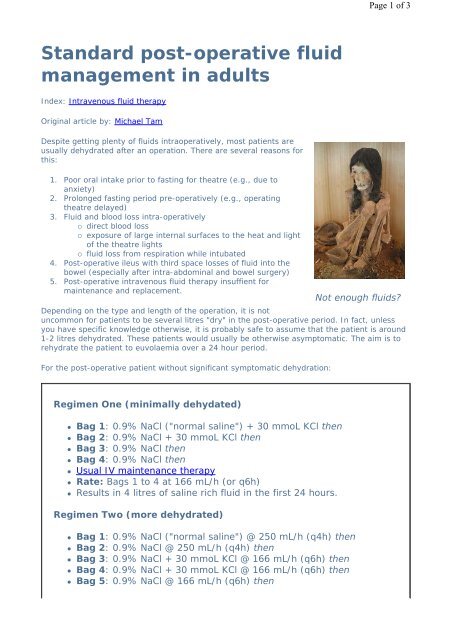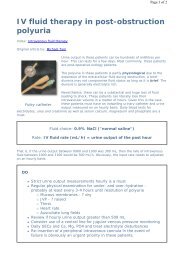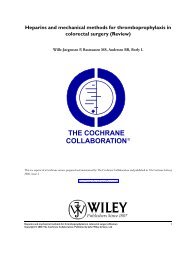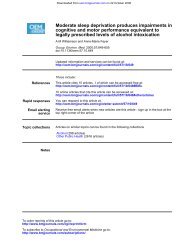Standard post-operative fluid management in adults
Standard post-operative fluid management in adults
Standard post-operative fluid management in adults
Create successful ePaper yourself
Turn your PDF publications into a flip-book with our unique Google optimized e-Paper software.
Page 1 of 3<strong>Standard</strong> <strong>post</strong>-<strong>operative</strong> <strong>fluid</strong><strong>management</strong> <strong>in</strong> <strong>adults</strong>Index: Intravenous <strong>fluid</strong> therapyOrig<strong>in</strong>al article by: Michael TamDespite gett<strong>in</strong>g plenty of <strong>fluid</strong>s <strong>in</strong>tra<strong>operative</strong>ly, most patients areusually dehydrated after an operation. There are several reasons forthis:1. Poor oral <strong>in</strong>take prior to fast<strong>in</strong>g for theatre (e.g., due toanxiety)2. Prolonged fast<strong>in</strong>g period pre-<strong>operative</strong>ly (e.g., operat<strong>in</strong>gtheatre delayed)3. Fluid and blood loss <strong>in</strong>tra-<strong>operative</strong>ly◦ direct blood loss◦ exposure of large <strong>in</strong>ternal surfaces to the heat and lightof the theatre lights◦ <strong>fluid</strong> loss from respiration while <strong>in</strong>tubated4. Post-<strong>operative</strong> ileus with third space losses of <strong>fluid</strong> <strong>in</strong>to thebowel (especially after <strong>in</strong>tra-abdom<strong>in</strong>al and bowel surgery)5. Post-<strong>operative</strong> <strong>in</strong>travenous <strong>fluid</strong> therapy <strong>in</strong>suffient forma<strong>in</strong>tenance and replacement.Depend<strong>in</strong>g on the type and length of the operation, it is notuncommon for patients to be several litres "dry" <strong>in</strong> the <strong>post</strong>-<strong>operative</strong> period. In fact, unlessyou have specific knowledge otherwise, it is probably safe to assume that the patient is around1-2 litres dehydrated. These patients would usually be otherwise asymptomatic. The aim is torehydrate the patient to euvolaemia over a 24 hour period.For the <strong>post</strong>-<strong>operative</strong> patient without significant symptomatic dehydration:Not enough <strong>fluid</strong>s?Regimen One (m<strong>in</strong>imally dehydated)• Bag 1: 0.9% NaCl ("normal sal<strong>in</strong>e") + 30 mmoL KCl then• Bag 2: 0.9% NaCl + 30 mmoL KCl then• Bag 3: 0.9% NaCl then• Bag 4: 0.9% NaCl then• Usual IV ma<strong>in</strong>tenance therapy• Rate: Bags 1 to 4 at 166 mL/h (or q6h)• Results <strong>in</strong> 4 litres of sal<strong>in</strong>e rich <strong>fluid</strong> <strong>in</strong> the first 24 hours.Regimen Two (more dehydrated)• Bag 1: 0.9% NaCl ("normal sal<strong>in</strong>e") @ 250 mL/h (q4h) then• Bag 2: 0.9% NaCl @ 250 mL/h (q4h) then• Bag 3: 0.9% NaCl + 30 mmoL KCl @ 166 mL/h (q6h) then• Bag 4: 0.9% NaCl + 30 mmoL KCl @ 166 mL/h (q6h) then• Bag 5: 0.9% NaCl @ 166 mL/h (q6h) then
Page 2 of 3• Usual IV ma<strong>in</strong>tenance therapy• Results <strong>in</strong> just over 4.5 litres of sal<strong>in</strong>e rich <strong>fluid</strong> <strong>in</strong> the first 24 hours.Post-<strong>operative</strong> oliguria/ significant dehydration will be covered <strong>in</strong> a separate article.Fluid volumeAssum<strong>in</strong>g the usual 70 kg previously healthy person, this means you should aim for:• 4-5 litres of <strong>fluid</strong> <strong>in</strong> the next 24 hours (versus the euvolaemic ma<strong>in</strong>tenance of around 3litres);• After achieive euvolaemia / good hydration, if the patient still needs IV <strong>fluid</strong>s, then thema<strong>in</strong>tenance rate should suffice.Fluid choiceFor someone with a <strong>fluid</strong> deficit, that <strong>fluid</strong> is best replaced with sal<strong>in</strong>e rich solution. That is:• either 0.9% NaCl solution (Normal Sal<strong>in</strong>e);• or Hartmann’s solution.PotassiumSome surgeons say that the body spares potassium <strong>post</strong>-<strong>operative</strong>ly so potassiumsupplementation is not required <strong>in</strong> the first 24 hours. Though this is true for the vast majority ofpatients, it is not universally true (e.g., and needless to say, it is <strong>in</strong> those patients that this isnot true that will potentially have life-threaten<strong>in</strong>g hypokalaemia).My op<strong>in</strong>ion is that you should give adequate potassium replacement for patients <strong>in</strong> the first 24hours <strong>post</strong>-<strong>operative</strong>ly rout<strong>in</strong>ely unless there is a specific reason not to.In procedures where there is a high likeihood of <strong>post</strong>-<strong>operative</strong> ileus (e.g., <strong>in</strong>tra-abdom<strong>in</strong>alsurgery and bowel surgery <strong>in</strong> particular), potassium supplementation is a must as third spacelosses <strong>in</strong>to the bowel are generally rich <strong>in</strong> potassium. Hypokalaemia, furthermore, prolongs<strong>in</strong>test<strong>in</strong>al ileus.I would give:• 1 mmoL of KCl per kg of body weight <strong>in</strong> the first 24 hours• ~ 60 mmol KCl (for ord<strong>in</strong>ary adult)• = 30 mmol KCl <strong>in</strong> two of the litre bags of <strong>fluid</strong> (premixed or otherwise)Additional losses
Page 3 of 3If a patient has diarrhoea or vomit<strong>in</strong>g, you need to replace this <strong>fluid</strong> on top of their ma<strong>in</strong>tenanceand <strong>post</strong>-<strong>operative</strong> replacement <strong>fluid</strong>s. You should consider this <strong>fluid</strong> as both sodium andpotassium rich and so a “litre” of vomitus or diarrhoea should be replaced with a litre bag ofNormal Sal<strong>in</strong>e + 30 mmol KCl.Third space lossesIn patients with an ileus or a small bowel obstruction (or for example, <strong>in</strong> pancreatitis), there canbe large amounts (as <strong>in</strong> litres and litres) of <strong>fluid</strong> “lost” to the bowel. This <strong>fluid</strong> will be sodiumand potassium rich.Usually, you will need to aggressively replace <strong>fluid</strong> (that is, many litres a day) with sal<strong>in</strong>e andoften with large amounts of potassium.Patients who are eat<strong>in</strong>gUsually, patients who are eat<strong>in</strong>g but require “supplemental” <strong>fluid</strong>s (i.e., <strong>in</strong>adequate oral <strong>in</strong>take)will only require small amounts of <strong>fluid</strong>. In general, <strong>in</strong>travenous potassium replacement is notrequired for these patients (even if they are hypokalaemic, you can usually use oralsupplementation).Try to calculate the amount of water actually required. For example, if they need 1L of water <strong>in</strong>addition to oral <strong>in</strong>take, then only give 1 litre <strong>in</strong> a day (as normal sal<strong>in</strong>e or dextrose solution). Ifno other <strong>in</strong>travenous access is required and <strong>in</strong>travenous access is difficult, consider asubcutaneous l<strong>in</strong>e (generally a maximum rate of <strong>fluid</strong> at about 80 mL/h). Do not put a dextrosesolution subcutaneously.Updated: Michael Tam (19 June 2006)Please read the disclaimer







